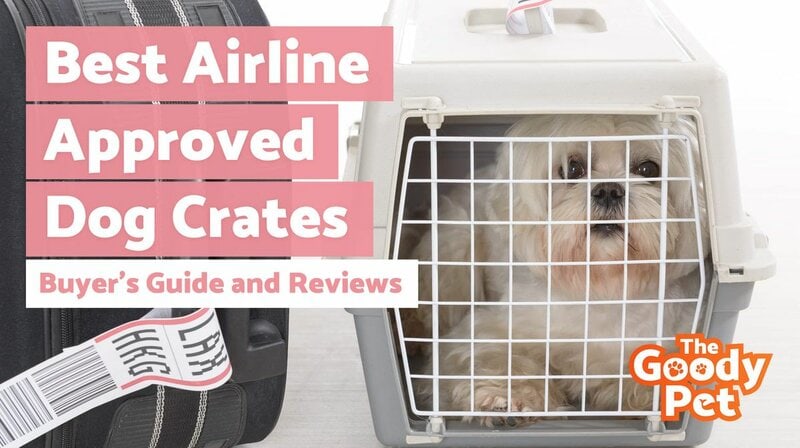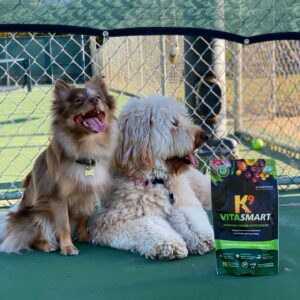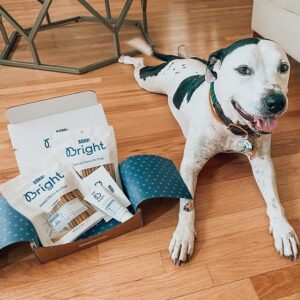Are you a dog owner who likes to take your furry friend on vacation with you? If so, you know that it can be a little tricky trying to find a way to transport your pup safely and comfortably. But with the right IATA-approved dog crates, it doesn’t have to be.
An IATA-approved crate should have dimensions measuring at least 100% wider, 50% longer, and 30% taller for the comfort of the dog during the journey. It should also have a container fitted inside to hold food or water, filled from the outside, without opening the entrance to prevent the dog from escaping. Apart from these two factors, we’ll recommend some of the best crates for air travel and tell you why they’re such a great option.
So whether you’re headed across the country or just across town, read on for additional tips and advice on IATA-approved dog crates!
#1 Petmate Sky Kennel
For those who want to offer their pets the gold standard, Petmate’s Sky Kennel offers a sturdy design and build that’s sure to keep your pets safe and stress-free.
Costing less than $120 for the 36-inch variety, it’s not the cheapest you’ll find on the market, but that extra money’s spent in the right places. Even then it remains more affordable than other top competitors, which can go for double the price.
As long as you have metal nuts, bolts, and screws for every hole, you’re good to take to the skies, and your best friend will get to enjoy 360° visibility, open ventilation on all four sides, and a durable shelter while you’re both up there.
For furry friends of every variety, Petmate offers their airline-approved crates in sizes ranging from 21 to 48 inches. They also stand by their work, offering a one-year warranty to cover you just in case of assembly or material defects.
Compared to others we found, the Sky Kennel ended up at the top here for a few reasons, as you can see. Few crates that offer durability and security are available at its price point, and the extra money you’d save on a cheaper competitor goes toward a better product. It also comes with “LIVE ANIMAL” stickers to be pasted on its sides so as to fulfill the airline requirements of an IATA-approved dog crate.
Pros
- The Petmate Sky Kennel is designed with openings on all sides, thereby making it possible for pets to observe their surroundings and giving them easy and continuous access to fresh air.
- This kennel is constructed to follow key airline requirements, such as having air holes on each side, protruding side handles, and a metal single-piece door.
- The deep food and water bowls that come with the kennel make it possible to feed pets during trips while avoiding spillage.
- The kennel’s durable and heavy-duty plastic construction doesn’t fall apart easily, thereby helping to keep pets out of harm’s way.
- The kennel is easy to assemble, and it comes with clear and concise instructions for assembly.
Cons
- Customers usually need to purchase and install extra bolts, nuts, and zip ties on the Petmate Kennel to meet construction requirements with certain airlines.
- Several customers are disappointed with the reliability of the 4-way locking mechanism on the kennel’s door, as it can fail occasionally and allow the pet to escape.
We vote this product as our top pick because of its compliance with many, if not most, airline cargo specifications.
#2 Aspen Pet Porter
While we don’t recommend you take the cheap route when picking a crate, everyone has a budget. For those not working with extravagant amounts, you’ll have to be particular with your choice, and it can be tough to check all the boxes.
Aspen has a solution for you. Their airline-approved Pet Porter kennel is reasonably priced and is engineered for your pet’s comfort and security. It provides the full package for far less than you’d expect, and they don’t cut corners anywhere. This dog travel crate even provides metal bolts, so you won’t have to worry about getting your own before going on your trip.
They even have a coded system where you can pick your idea crate depending on the breed. One customer warns, however, that this might not be the best choice for dogs that have a history of breaking out of their cages in the past.
There are other carriers that you’ll be able to find at this price, and there are some that are even cheaper. However, there are few offering what the Pet Porter does. You might need to keep to a budget, but you can rest easy knowing that you’ll have a decent selection. It is easy to clean and easy to stuff with treats. We think that the Starmark Chew Ball is a great buy for any dog parent.
Pros
- The Aspen Pet Porter comes equipped with essential pet accessories, such as pet toys and beds, litter box accessories for cats, and leash cable tie-outs to ensure a comfortable traveling experience for pets.
- Its nut-and-bolt design facilitates easy assembly and disassembly, which makes cleaning easier.
- The kennel’s large size provides plenty of room for pets to comfortably stand, turn around and lay flat.
- The crate has ample ventilation openings to provide constant fresh air for pets.
Cons
- The absence of a handle or wheels lowers the portability ease of this large kennel, especially during traveling.
- Instead of metal grills, the presence of air-cut holes for ventilation may cause the kennel to be damaged and structurally weakened by pooches that tend to chew out of boredom or fear.
#3 IRIS USA Easy Access Pet Travel Carrier
If you’re like most of us when you’re traveling, you’ll need to have your hands free as often as possible. IRIS understands that and kept it in mind when designing their airline-approved air travel crate, which features a folding handle (two on the larger one) on top.
Depending on whether you get the 19 to 23, 26, or 34-inch varieties, it’ll look a bit different, but the benefits are consistent. With an open design and strong and lightweight build, dogs up to 75 lbs will be able to relax and breathe easily.
Convenience doesn’t stop there: if you go for the larger version, you can collapse it for easy storage once the trip is over.
If you want a convenient, affordable option, and your furry friend isn’t too big, you’ll enjoy this crate. They’ll be well-rested, and you’ll be the same knowing you won’t have a hassle when moving them around.
Pros
- This pet travel carrier comes with either one or two easy-grip handles that fold to provide better storage.
- The IRIS carrier comes with top and side doors that provide fast access to pets and also make it easier to load pets into the carrier.
- The carrier is simple to assemble, and it also comes with assembly instructions that are easy to follow.
- The carrier comes with easy-to-operate locks that aren’t too hard to squeeze open.
- The inclusion of a food-and-water bowl with this carrier makes it more convenient to feed pets.
Cons
- Several customers have complained about the plastic construction of this kennel falling apart easily.
- The IRIS’ thin plastic construction flexes and bends a lot when loaded, and in some cases, this causes the carrier’s front door to pop open.
#4 SportPet Designs Rolling Plastic Air Travel Crate
As if four-wheel luggage wasn’t enough of a life-saver for travelers, SportPet Designs offers a rolling crate, airline-approved of course, to help pet owners glide through the airport.
When you’re preparing for takeoff and need to get the wheels off for their security and IATA compliance, you won’t face too many problems. Thankfully, they snap right off with minimal effort, and assembly won’t be very difficult either.
With six available tiers (the smallest doesn’t have wheels), pets of all shapes and sizes are able to enjoy this kennel. Almost every option is under $110, too, so convenience doesn’t come at too lofty of a cost.
This crate holds its own amongst many in its class, and the wheels make a difference. It’s a wise purchasing decision for the owners of any size of a canine companion.
Pros
- The kennel has four detachable wheels that can be locked in position when snapped, thereby improving the convenience during transportation or traveling with pets.
- The SportPet crate includes water and food dishes, live animal stickers, nuts, and bolts to comply with IATA airline requirements.
- The two folding plastic handles located on the crate’s top make it easier to carry and store this product.
- The crate’s entrance comes with two pre-drilled holes on the top to securely fasten the metal door with zip ties or padlocks, ensuring that the door stays closed during traveling.
- The travel crate has ten clamps that can be easily attached and detached, thereby making assembly and disassembly easy.
Cons
- The sizing chart for the SportPet is usually inaccurate, and this typically makes this travel crate either too big or too small for pets after purchase.
- Several customers have reported the structurally weak wire window of the travel crate as it falls off eventually when used to house pooches with destructive chewing tendencies.
#5 Petmate Ruff Maxx Kennel
This Petmate offering, coming from the Remington brand, is specially geared towards those with durability and security in mind. These airline-approved crates have a tough outer shell, wire doors, and a locking mechanism sure to keep them inside.
One owner mentions in his review that his dog gets anxious and has broken out of other cages. However, the dog wasn’t able to crack this one, and it grew to love it!
Their biggest size, which can fit dogs up to 90 lbs, is perfect for outdoor activities once you land. Most dogs can get in on the fun, though; their varieties range from 19 to 40 inches long.
If you need something with a little extra muscle to hold up to your buddy, then this would be one of your better choices, especially considering the reasonable price point.
Pros
- This kennel from Remington, which comes in two pieces, is easy to set up, and the product package typically includes nuts and bolts for quick assembly.
- The kennel features an innovative camouflage design that is ideal for outdoor experiences for dogs.
- It comes with zip tie holes and a squeeze latch for the door so it doesn’t bust open while in transit.
- Openings located around the kennel provide pets with better visibility and good ventilation.
Cons
- Large-sized versions of this kennel have multiple large indents that may be uncomfortable for a medium-sized dog to lay on.
- The kennel’s plastic construction is of questionable quality, and there have been reports of the kennel getting damaged while in use.
#6 Petmate Ultra Vari Dog Kennel
While Petmate has a few competitors in the ring, the Ultra Vari kennel is a solid choice for medium-sized to larger companions. It’s especially good for dogs that deal with anxiety when away from their owners.
One owner, who purchased a larger version for their Pitbull mix, saw just as much. Their dog was breaking through plastic crates, wired ones, and was even doing damage to a “safe room” they designated.
Once they picked up this airline-approved crate and did the proper training, they were pleased to see that there was nowhere for the dog to bite through when they wanted to.
Our pets are going to be difficult sometimes. It’s up to us to make sure they don’t make a mess. With the Ultra Vari, your job becomes way easier, and your pet’s happy too.
Pros
- The kennel, which comes in three pieces, is simple to install; The bolts and nuts can be fixed by hand and without needing tools.
- The kennel’s durable and heavy-duty plastic construction is sturdy enough to support and house pets of various sizes.
- The kennel’s raised interior, which is devoid of sharp edges, is comfortable for pets to lie down on.
- Wire ventilation openings at the sides of the kennel provide ample ventilation for the pet, and they are durable enough to withstand excessive chewing.
Cons
- The small and medium-sized versions of the dog kennel don’t come with dishes for feeding pets, as well as live animal stickers to meet airline requirements, but these items can be purchased separately.
- The kennel’s lock mechanism tends to come apart easily, thereby making it possible for the pet to escape.
#7 Chesapeake Bay Heavy-Duty Rolling Airline Pet Crate
The Chesapeake airline pet crate is a sturdy metal construction designed to facilitate pets’ more comfortable housing during air and road trips.
With a weight of 10.25 lbs, its physical dimensions are 27 inches long by 20 inches wide by 19 inches tall. The abundance of ventilation openings on all sides of this pet crate ensures adequate airflow for pets, and flexible wheels make it possible to conveniently move this heavy-duty crate around.
This pet crate contains two dishes for holding pet food and keeping your pets fed during the whole trip. And metal bolts and nuts included in the package make the assembly and disassembly of the crate considerably effortless.
This is certainly a premium option. However, it’s also one that’ll be sure to keep your pup secure and comfortable. Boasting security, space, and some optional add-ons, you’d be well-served going with this.
Pros
- The Chesapeake crate comes fitted with two bowls attached to the door, which makes it easier to feed pets and give them water without having to worry about spills.
- It comes with four wheels which can be locked in position when snapped, and a handle located on the top, making transporting this crate effortless.
- The crate comes in two readymade halves, is easy to prepare for use and the assembly instructions are clear and helpful.
- The crate’s durable construction, which comprises thick walls and metal bolts, can be used for a significant period without breaking down.
- This product has tie-down holes, which makes it easy to secure the crate in place and prevent unnecessary movements.
Cons
- Some customers have complained about their pets being unable to lay straight in the crate due to a much narrower inner part of the crate.
- The 25-mm wire mesh on the carrier’s door is reported to be too wide such that the pet’s paws can get stuck.
Airline-Approved Dog Crate Buyer’s Guide
As you think about which crate you want to purchase, it’s important to know that some are more compliant with airline policies than others. Since they aren’t created equal, arming yourself with the right information will be your best bet.
IATA Airline Standards
Before you reach anywhere near your credit card, you’ll first have to make sure that the crate you’ve chosen is compliant with the standards of the IATA, also known as the International Air Transport Association. Simply put, these are the law for pet travel in the skies.
To make sure that your pet is safe and comfortable, they have requirements and restrictions for every crate that comes on board. They are as follows:
- No matter which airline-approved crate you choose, you’ll need to adhere certain stickers to the surface. They first require three, one on the top and each of the sides, that say “LIVE ANIMAL.”
- They also need you to have directional stickers, along with a Shipper’s Declaration stating when they last had food and water, affixed to the crate.
- Along with these stickers, you also need to adorn your crate with your contact information and the name of your pup. You can do this with any sort of strong tape, especially duct tape.
- The floor of your crate has to be solid and not allow any leaks.
- For safety reasons, the crate has to be quite robust, and they only allow crates made from rigid plastic, fiberglass, metal, weld metal mesh, solid wood, or plywood (the allowance of the last two depends on the airline).
- Your pet has to have ample room in their crate, to the point where they can lie down, turn and stand with ease.
- The IATA itself might not require it, but quite a few airlines will turn you away unless you use metal nuts, bolts, and screws to secure your kennel.
- To further enhance security, you’ll have to have holes on the corners of your crate of choice to allow for the fixation of cable ties.
- When you’re traveling domestically, you’ll need to be sure that there’s ventilation on at least two sides of the kennel. International air travel, due to the longer journeys, requires vents on every side.
- As we mentioned before, you can’t have wheels attached to the crate when getting it prepared to go on the plane. They’re great for moving through the airport, but once you check them in you’ll have to take them off.
This is a non-exhaustive list of requirements for an airline-approved dog crate for pet travel. Read the full list here.
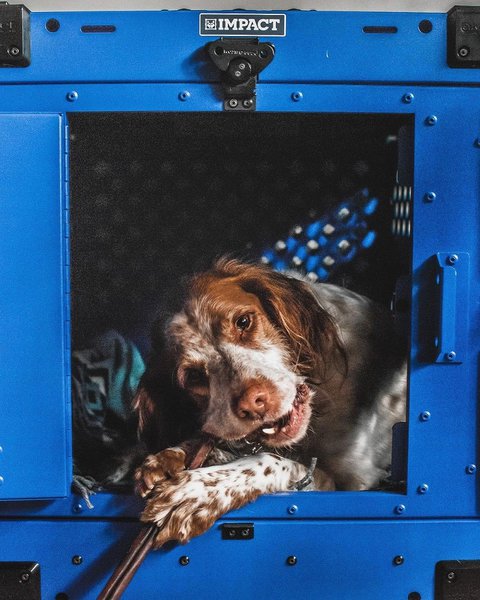
Crate Training For Your Pooch When Flying
Air travel can be an intense experience for any dog, no matter how big and tough they are. Making sure that they’re ready for the journey is vital for their peace of mind. It’ll be good for yours, too.
PetRelocation, a company dedicated to safely moving pets across the world, has a few good tips for people crate training their dogs to get ready for a flight.
Start Training Without The Crate’s Top
They suggest you start the process as soon as you know you’ll be traveling with them in tow. They suggest this mostly because you’ll have to start the process from the ground up.
No, really, they recommend you get them used to the bottom of the crate before you attach the top. Getting them familiar with the bottom surface will make the introduction of an enclosing roof much quicker.
Introduce Your Pup’s Belongings
Throughout that process, it helps to get them to spend more and more of their time in there. Whether you decide to feed them in there, put their bed in there, or involve it in playtime, anything positive that gets them in there is the way to go.
Positive Reinforcements Are Crucial
Speaking of positive, that sort of reinforcement is pivotal in getting them to accept going inside and staying there for increasing amounts of time. When they make the move to explore, make sure to use a happy voice and let them know you’re proud.
This works well into playtime. Point inside of the crate, say the word “crate,” and throw their toy into the furthest corner to make sure they have to go all the way in to grab it.
Once they do so and come out, offer them their due belly rubs, yummy dog treats, and positive insistence that they’re a very good boy or girl. Make sure you let them out, though, since locking them in at the end can ruin the game quick.
Be Patient And Repeat The Steps
You’ll want to avoid any setbacks as much as you can since patience is the name of the game. The ideal time frame is a few weeks, but things can take a bit longer or shorter depending on their comfort level when they’re away from you.
Try keeping them in there for increasing intervals of time. It can be while you’re taking out the trash or picking up the mail, then going out for a quick bite to eat, then working out for an hour or two.
You shouldn’t be keeping them in there for much longer outside of an international trip, though.
Don’t Crate Them For Too Long
Dogs want to run free, and if you keep them in the crate too long it can start to seem like a punishment. Getting them in after that is a nightmare.
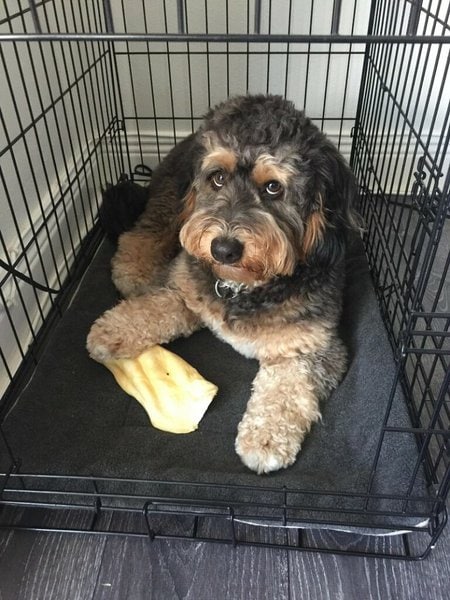
Once you get them out of the kennel after a long flight, you might have a surprise, or several surprises, waiting for you inside. We can’t stop nature, so that means we have to clean up after it.
When you’ve got a conventional plastic travel crate, there are a few simple things you can do to get things looking new.
First, get your spray bottle ready, and mix up with some water and a bit of mild dish detergent, filling about 10% of the container with that. Spray down the crate and get the most intensely affected areas nice and soaked.
If you’ve really got a mess to work through, then you’ll be advised to arm yourself with a sponge to work in the mixture.
Wipe off the area with a paper towel, and do it again if you’ve got more mess to get through. Once you’ve repeated that process to your liking, rinse off the remaining soap with water and dry off the crate.
Make sure to also take apart the crate when you do this cleaning. Things can get tricky in the seams and corners, and you won’t do yourself any favors if you keep those areas concealed and hard to reach.
If your crate is past a certain point, you’ll have to enlist a hose to break down the big messes before you get in to take care of the nitty gritty.
After you use the hose, you can go and grab the aforementioned detergent and water mix. If you’re looking for an effective alternative, though, you can break out some Clorox wipes (a generic version would work), or even a bleach and water solution.
The exterior faces its own challenges. It might not have to deal with #1 or #2, but it can get plenty dirty without any help from them.
You can try one of the cleaning solutions or wipes, although a Mr. Clean Magic Eraser, or a generic variety, will be better suited for taking care of the deeply-ingrained dirt stains.
By the way, make sure to steer clear of any cleaning products with ammonia in them. Since it’s an odorous chemical that’s also present in their urine, they’ll smell that and think it’s okay to use the crate as a bathroom.
Whichever cleaner you use, though, you’ll have to protect yourself from it. Wear gloves throughout the whole process to make sure you don’t run into trouble with any corrosive chemicals.
Final Thoughts
You’re going to have quite a few options for airline-approved crates and kennels, and you’ll have a lot of things to consider when you’re shopping. Does it have enough room? Is it stable and sturdy enough for the plane? Will the dog have a hard time getting out?
Out of everything available, our top pick aligns with all IATA requirements as long as you get some metal nuts, screws, and bolts. You’ll also have plenty of size options to be sure your best friend is as comfortable, if not more comfortable, than you are in your seat.
Lastly, it proves that the best product available isn’t always the most expensive. It’ll be an investment, but it won’t feel like one for your wallet.

